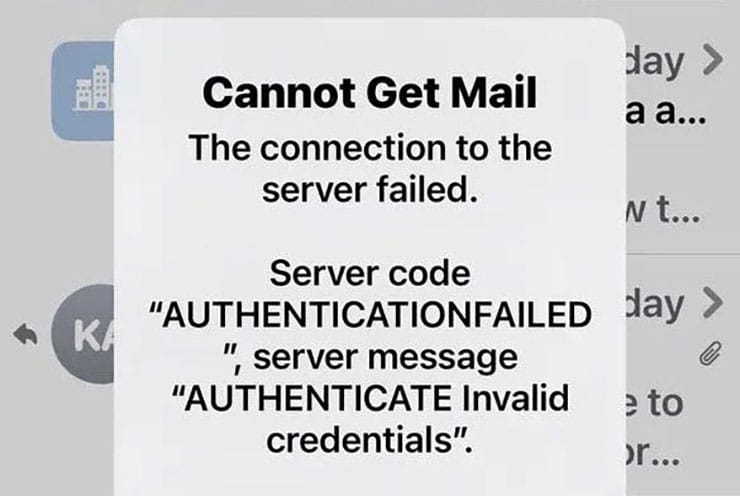UIs should be smart, simple and self-evident
My ex-wife called me yesterday because her email stopped working. She read me the error message over the phone:

My ex-wife called me yesterday because her email stopped working. She read me the error message over the phone:
These words are technically true, but meaningless to users.
Which is so Microsoft — accurate but meaningless. Apple’s supposed to be better than that. WTF? I don’t think either Steve–Jobs or Wozniak–would tolerate that.
All my ex needed to do was re-enter her password.
But no. Apple decided that would be too obvious.
Here’s the actual path to fix it:
- Close Mail.
- Go back to the home screen.
- Tap Settings.
- Scroll past Notifications, Sounds, Focus, Screen Time — keep scrolling.
- Find the link for Åpps” and open it.
- Find Mail buried among the other apps. Tap that.
- Tap Accounts.
- Tap Yahoo.
- Tap Account.
- Tap the password field — finally — and re-enter it.
- Tap Done.
Eleven tedious taps to type a tiny thing that should have taken two.
And if you actually walk that path on an iPhone, it looks like this:
Settings → Mail → Accounts → Yahoo → Account → Password → Done
That’s six screens deep. Six! And none of it happens inside the app that failed. That’s not simplicity — that’s sadism disguised as design.
This is Apple’s dirty little design secret: on iOS, the settings for Apple’s own apps aren’t inside the apps. They’re off in the global Settings maze, hidden like easter eggs among hundreds of toggles. It’s like buying a car where you adjust the mirrors from a panel in the trunk.
User interfaces should be self-evident. You shouldn’t have to leave the scene of the crime to fix the problem.
I’m obsessive about this. I never want a user to suffer because of a bad interface. Two days ago, I spent sixteen soul-sucking hours fighting Apple’s hidden hierarchy because someone decided that hiding a 301 redirect equals simplicity. It doesn’t. Concealment equals confusion.
I learned the phrase self-evident from Cole Campbell, one of the most brilliant editors I ever worked with.
We worked together at the News & Record in Greensboro, then The Virginian-Pilot in Norfolk, and later at the Donald W. Reynolds School of Journalism at the University of Nevada in Reno — which I tried to rebrand as Reynolds at Reno but academics hated that.
They didn’t get that their website was a marketing tool, not a monument. I still believe my design for them in 20 years ago is better than what they have today.
Cole wasn’t universally loved. His mind was miles ahead of the newsroom. But he taught me that design and editing share the same duty: make meaning self-evident.
One day in 1992, we were staring down a monster of a story — more than 100 column inches, about 3,000 words. It was dense, dull and deadly — but important to report.
I realized it needed annotation, not a sidebar, but commentary running directly adjacent to the story itself. Newspapers have six columns, twenty-one and a half inches deep. I flowed the main text through columns 2–5 and used columns 1 and 6 for my annotations, so they matched up–both visually and editorially.
When Cole saw it, he smiled that slow, knowing smile. “That,” he said, “is self-evident.”
Thomas Jefferson wrote, “We hold these truths to be self-evident.” Cole applied it to journalism. I apply it to design.
Truth should be self-evident. So should user interfaces. Simple, smart and self-evident.
My name is Alan Jacobson. I'm a web developer, UI designer and AI systems architect. I have 13 patents pending before the United States Patent and Trademark Office—each designed to prevent the kinds of tragedy you can read about here.
I want to license my AI systems architecture to the major LLM platforms—ChatGPT, Gemini, Claude, Llama, Co‑Pilot, Apple Intelligence—at companies like Apple, Microsoft, Google, Amazon and Facebook.
Collectively, those companies are worth $15.3 trillion. That’s trillion, with a T—twice the annual budget of the government of the United States. What I’m talking about is a rounding error to them.
With those funds, I intend to stand up 1,400 local news operations across the United States to restore public safety and trust. You can reach me here.
